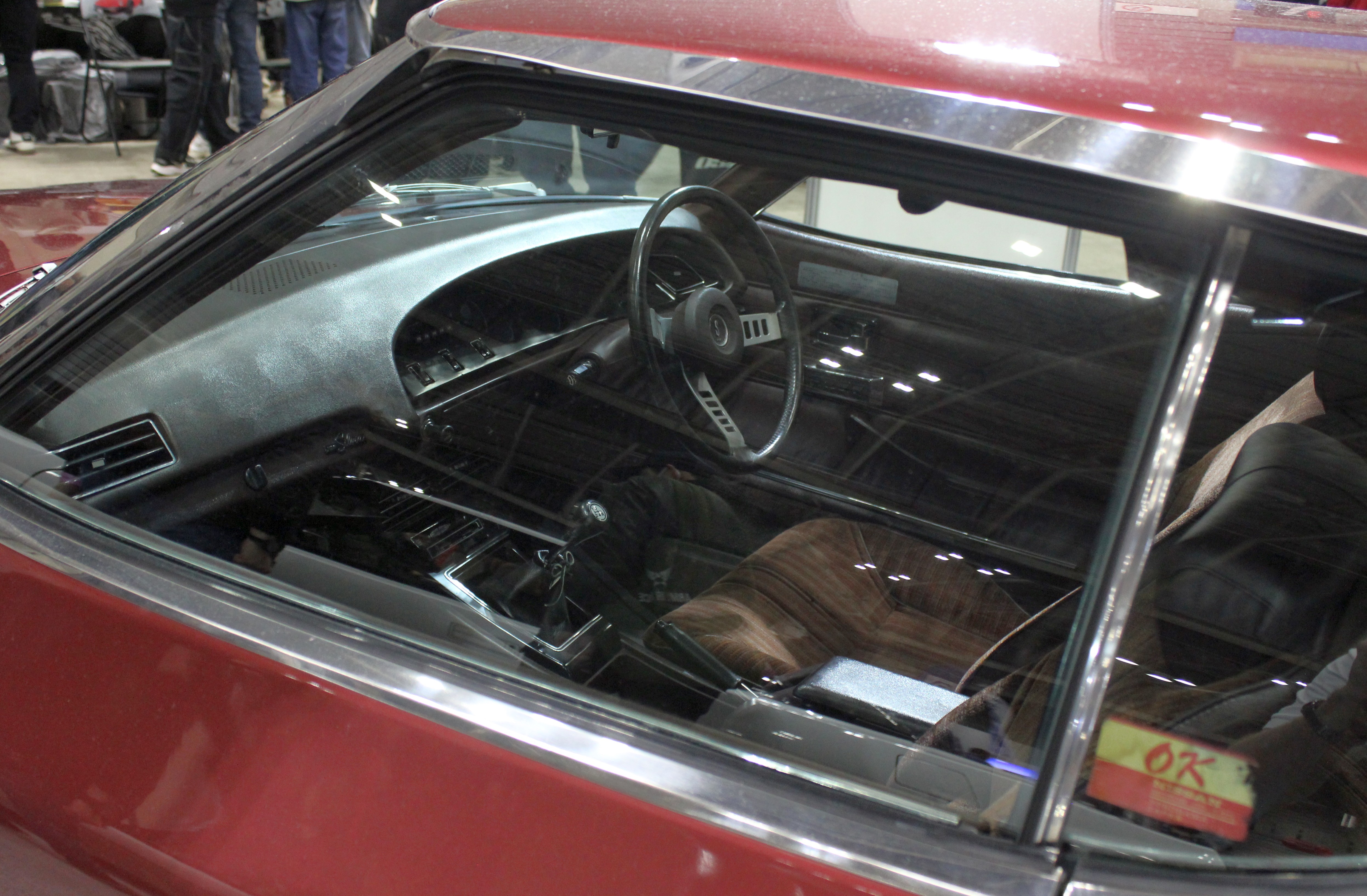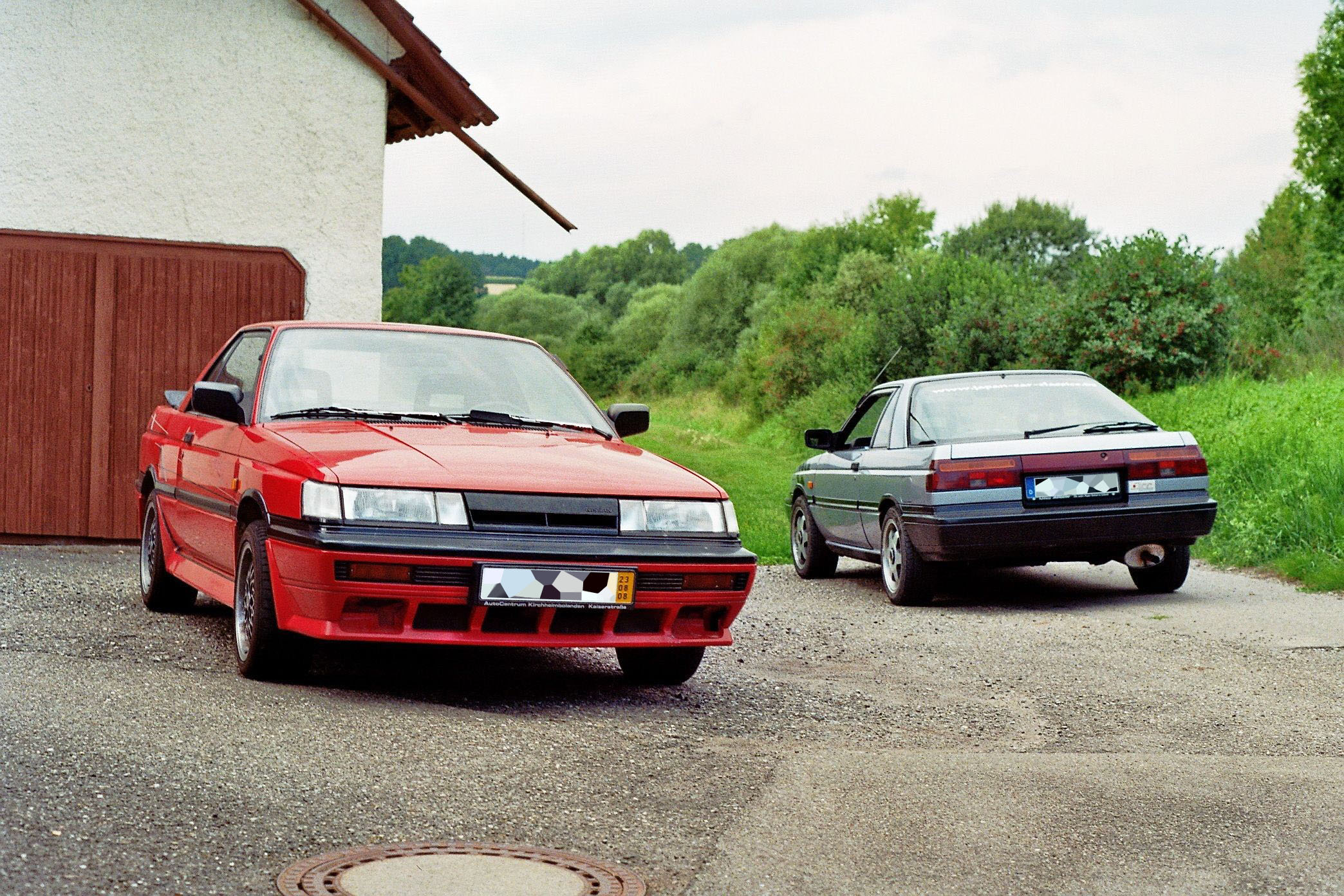After seeing the poster for the Nostalgic 2days (“The largest classic motor show in Japan”) at a 7-11 in a busy Tokyo metro station, I immediately made a note in my calendar, and asked my friends if we want to go together.

In Germany, “Classic Motor Show” usually means “Mercedes and Porsche Motor Show”. Not trying to be presumptuous – I believe these cars are beautiful pieces of history, but they are just not my cup of tea. My passion is more focused on the Asian car culture, which is why I usually didn’t bother much to visit these shows back home. On the contrary, what would a classic car show in Japan be like? I decided to give it a try.
The venue opened at 10AM, and anticipating the large amount of guests on every major event in Tokyo, I arrived about 20 minutes earlier. This turned out to be a great decision, because otherwise I may have missed this beautiful Trueno coupe in the rare black over silver two-tone paint, searching for a parking lot.

Within 10 minutes, I saw one AE86, one S13 180SX, one RX-7 FD, one MR2 SW20 and a Golf II.

As expected, the venue was quite packed, but after 5 minutes of queuing I was inside and immediately knew I made the right decision. The majority of cars on display were Japan-made from the 70ies, 80ies and early 90ies. Seeing this collection of perfectly preserved and restored Laurels, Zs, and Skylines presented right behind the entrance gave me the confidence that I went to the right place.
Classic Skyline

These days, I have a slight obsession for the fifth generation Skyline (C210/C211) introduced in 1977. Nicknamed “Skyline Japan”, I recently encountered an almost gutted rusty shell at a small workshop in Chiba, which sparked my interest in these.

I have to admit, when I saw the gutted shell, I didn’t expect that the complete car would look that impressive.

If I could choose only three cars for my personal hall of fame, the Skyline R30 would be in it (the two others are the Sunny B12 Coupe, and the Corolla AE86). Seeing that roofline and slick C pillar just gives me weak knees.

This Skyline is equipped with the FJ20ET engine. Note how every piece of metal, plastic and even the smallest screw has been restored with incredible attention to detail. I would love to know the secret how to restore the matte black color of plastic bumpers.

I wonder what these metal huts on top of the strut towers are. Are these for electronic suspension adjustment?

Note how all unpainted metal parts have been galvanized.

The later R30 variants with the slim headlights and the longer bonnet are called “Tekkamen” (鉄仮面, iron face mask). The older variants with the larger headlights and black grille are slightly less popular. The R30 Skyline is very famous in Japan, partially due to its appearance as the tuned police car in a TV series from the 80ies called Seibu Keisatsu (西部警察, the western police department). A modified red-black R30 Skyline called “Machine RS-1” was used to chase down criminals in this series. Not surprisingly, Nissan sponsored the show.
Not too long ago, Hachette offered an insane detailed 1/8 scale model of Machine RS-1, similar in size and level of detail as the current DeAgostini AE86 model.

The red-over black paint job looks great on this Nissan.


Going from the 70ies to the late 80ies, we had this sexy triplet of R31 Skylines, all in 554 Midnight Glow Blue. This center R31 seems to be equipped with the GT Auto Spoiler, an electronically retractable front spoiler.
Look how exciting these electronic gadgets were back then. What is left of that excitement today? These days, manufacturers try to make you believe that an electronically actuated hatch is what you need. Sorry, I’m not really interested.

The installed RB20DET engine is the first iteration of the legendary RB six-cylinder engine. ECCS (Electronic Concentrated Engine Control System) was Nissan top fuel injection technology in the late 80ies, sporting microprocessor controlled multi-port fuel injection with direct coil on ignition.
Older and Newer Nissan S-Chassis

Fitting modern engines into older cars is quite common, but how about the other way around? This Nissan L6 engine with carburetors and ITB has been transplanted into a Silvia S14.

This S12 is a German-model Silvia, manufactured and sold for the German market. It was imported to Japan, and still carries the German license plate. Note the iconic Ronal Turbo wheels, a popular choice for classic cars in Europe.

In Europe, the S12 was available with the newer CA18ET single-cam turbo engine, and the slightly older FJ20E DOHC NA engine. These models came with a sporty little bonnet scoop to make space for the larger engine. Note that all the stickers in the engine bay are labeled in English, French and German, confirming that this is a EUDM model.

The original German Fahrzeugschein was exhibited next to the car, revealing that this Silvia had only one previous owner, who kept it from the 1980ies until 2019. During that period, Dillingen an der Donau was the hometown of this Silvia. This southern area of Germany has quite cold and snowy winters, causing severe salt corrosion within a few years. This is why German car enthusiasts usually avoid buying older cars from that region. With this Silvia being entirely rust-free, it must have been well-kept in a dry garage.

I never cared much about the pre-S12 Silvia, but this Silvia S10 made me change my mind. What a beauty, and what a perfectly matching color! I love the body lines, the C-pillar shape, and the characteristic external A-pillar antenna. And the wheel choice is such a perfect match.

The well-kept paint and interior, and the perfect condition of the vehicle, left me speechless.

Having the original “Nissan OK” factory sticker in place 50 years after production is just incredible.
Other Classics from Japan and the World

Is there a car that is more Atari than the Subaru Alcyone, parked next to the Silvia?

Many years ago, I had the honor of driving a friend’s Alcyone home from the seller. Driving an Alcyone is something that should be on your life’s bucket list, too!
Going further down the venue, this heavily modified DeLorean attracted my attention.

For those of my readers that don’t speak German, let me translate the labels on this DeLorean. The sticker on the door, “Kotlett”, means cutlet. The rear wheel arches are covered by ham (“Schinken”). The rear triangle window is sponsored by “Lende”, i.e. loin. “Haxen” is knuckles (many tourists like to eat “Schweinehaxe” in Germany – pork knuckles). You get the point.
After doing some research, I realized that this DeLorean is paying homage to Porsche’s 917/720 rosa Schwein.

Mazda’s classic car lineup was also very impressive. The Mazda Cosmo L10 from the late 60ies is such a beautiful car. A while ago, I saw a very cool looking paper model kit of the Cosmo in a bookstore.

I considered buying it, but unfortunately, I didn’t. By now, they are all sold out, making me regret my decision.

The Mazda RX-500 is a rotary concept car, displayed first at the 1970 Tokyo Motor Show. The RX-500 drove in under its own power. It wrapped the audience in a cloud of blue exhaust fumes from the double-rotor Wankel engine.

To be honest, I have 0 clue about older Sunny B110, but I think these cars are really cool little nuggets. They somehow represent the true origins of car culture of every generation: cheap cars that look cool and are fun to drive.
The pickup variant (B120) of this generation Sunny was sold until 1989 in Japan, and is still a common sight on the roads of Japan, as a popular choice among enthusiasts.

According to Wikipedia, the A12 engine uses pushrods to activate the valves, and is equipped with individual throttle bodies and Weber carburetors. A factory A12 engine makes about 70hp. As I wrote, I have no clue how these engines work or what choice of carburetors to use. These cars are probably a generation of car culture ahead of me, but perhaps that A12 engine is somewhat the 70ies equivalent of the SR20?

The last car I took a closer look at was this BMW Isetta. I had a brief chat with the owner, who turned out to be a big fan of German Microcars, and also owns a Zündapp Janus and a Messerschmitt Kabinenroller. Thank you for letting me having a seat in your BMW!
Stores & Reproduction Parts
At the end of my visit, I passed through an area of aftermarket part suppliers, and booths selling original or reproduced car parts. Fujitsubo had a tombola. If you win, they would manufacture a custom exhaust for a car of your choice.

The amount of engineering that gets put into reproducing old car parts is astonishing. What you are looking at is the 3D-printed sand core of a Nissan L6 cylinder head casting. This sand core is placed inside a mold, where it is used once in the casting process of a cylinder head.

After the aluminum is cooled off, casting and core are removed. After knocking out the sand, machining, tapping and valve seat installation, you have a band-new Nissan L6 cylinder head. You can find more details of this insane project on Instagram.

The famous AE86 Tec-Art’s shop offered almost every body part for the AE86. The available spare part supply for the AE86 has become fairly impressive, offering quarter panels, fenders, rear trunk flooring, rocker panels, bumper mountings, bonnets in steel and aluminum, and much more.
My Conclusion of Japan’s Largest Classic Motor Show
Overall, the venue was a great visit! I highly recommend you visiting it if you are interested in JDM classics. The venue itself is not super-huge: the entire show is located in one very large hall, and you can easily visit everything in 4–6 hours. To me, it was a great day, and combining it with a delicious late lunch in Yokohama made it a brilliant experience. Hence, if you happen to be in Tokyo when the next Nostalgic 2days happen, make sure to visit it!



